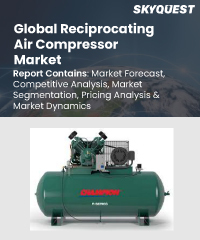
Report ID: SQMIG20I2217

Report ID:
SQMIG20I2217 |
Region:
Global |
Published Date: April, 2024
Pages:
202
|
Tables:
94 |
Figures:
76
Reciprocating Air Compressor Market size was valued at USD 4.45 Billion in 2023 and is poised to grow from USD 4.72 Billion in 2024 to USD 7.53 Billion by 2032, growing at a CAGR of 6% during the forecast period (2025-2032).
The market for reciprocating compressors is expanding at a compound annual growth rate (CAGR) that is being driven by rising demand from several end-use industries. Refineries, the pharmaceutical sector, CNG and LNG storage facilities, and other locations have higher requirements for reciprocating compressors. With an emphasis on retrofitting existing systems, these sectors are gradually implementing eco-friendly, user-friendly, variable-speed systems with increased efficiency. Particularly noteworthy are the outstanding performance capabilities that reciprocating compressors exhibit in high-pressure and high-power conditions.
Participants in the market for reciprocating compressors are predicted to give greater importance to factors like improved durability, gas flow limitation, rotational assistance, and effective heat control. Manufacturers place a strong emphasis on thorough pressure pulsation monitoring and thermodynamic effectiveness. Since medicinal gasses like hydrogen, oxygen, and helium are used in pharmaceutical applications, monitoring and reducing pipe vibration remain crucial. To identify and repair unsolved issues that might possibly cause significant harm to reciprocating compressors, vigilant vibration monitoring becomes essential. The industrialization, investments, industrialisation, and replacement needs are anticipated to drive the reciprocating compressor market.
Reciprocating compressors are essential to the chemical and petroleum industries and work largely by compressing air. Refinery activities, as well as CNG and LNG transport and storage facilities, have a considerable positive impact on the worldwide compressor industry. The need for reciprocating compressors is expected to increase across a number of industrial industries, including the automobile sector. Reciprocal compressors' numerous uses in a variety of sectors are anticipated to fuel market expansion, with an emphasis on enhancing rotational support, regulating gas flow, and extending equipment longevity. As a result, this will encourage income development in the market for reciprocating compressors.
However, there are several limitations on the compressor industry, such as the prevalence of fake compressor designs and fierce pricing rivalry. Another reason restricting reciprocating compressor usage is their comparatively lower capacity density, which results in lower operating speeds. Furthermore, the lifespan of particular parts, such as disc and reed valves and piston rings, places limitations on the overall profitability of reciprocating compressors in the larger market environment.
Our industry expert will work with you to provide you with customized data in a short amount of time.
REQUEST FREE CUSTOMIZATIONWant to customize this report? This report can be personalized according to your needs. Our analysts and industry experts will work directly with you to understand your requirements and provide you with customized data in a short amount of time. We offer $1000 worth of FREE customization at the time of purchase.

Report ID: SQMIG20I2217